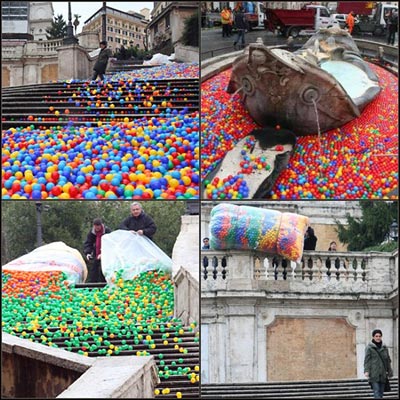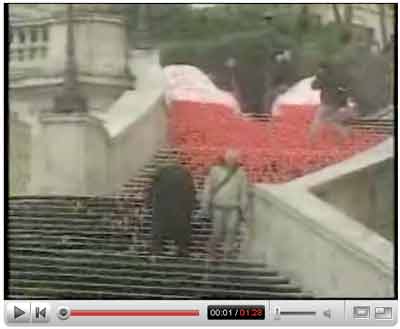The other day, half a million plastic balls bounced down the Spanish Steps, one of Rome's most visited and historic public places. Many visitors, picture-takers and members of the media were caused to wonder 'what's up with all these balls?'
The other day, half a million plastic balls bounced down the Spanish Steps, one of Rome's most visited and historic public places. Many visitors, picture-takers and members of the media were caused to wonder 'what's up with all these balls?'

(photo by Flickr user mareadjrock)
What's up, in my perspective, is a reminder that the public places of the world truly do belong to us all -- and are subject to whatever beautiful, horrible and cracked-out things we want to use them for.
The guy who dropped the balls says he was trying to represent the Italian government's "corrupt" system, with each ball representing a lie told by politicians. Graziano Cecchini, the same guy who dyed the waters of Rome's Trevi Fountain blood red in October, was promptly detained by police after emptying bags full of thousands of small plastic balls at the top of the historic staircase.
The video linked above shows the flow of balls down the staircase as confused and amused onlookers look on. It's a real-life, though less compelling, version of a commercial from a couple years back in which a bunch of bouncy balls were dropped down a hill in San Francsico by a private company to sell TVs.
You could call what Cecchini did vandalism, activism, littering, public art, or any number of adjectives. But the definition doesn't really matter as much as the (probably unintentional) statement it makes about the utility and inherent democracy of public spaces. These are places built for use and reinterpretation by the public. Especially in older cities, the public for whom these public spaces were originally built have been dead for hundreds of years, meaning the places are subject to be used and abused as the subsequent publics decide. This can take the form of riots, farmers markets, parades, and, yes, a staircase covered with balls.
This act is a reminder that we need to keep public ownership of our historic public places, and sustain that mentality as our cities build new places intended for the public. A recent article from the Los Angeles Times Magazine looking at the new public spaces being built in the city determined that nearly all of them were "shaped, controlled or compromised by private, commercial or other interests." Many things in our modern lives are owned or sponsored or presented by some major corpooration, and I assume the public spaces in other cities beyond L.A. are experiencing the same "privatization" discussed in the article.
Cecchini's balls (which, you have to admit, must be huge) are an exercise in civil disobedience and a call to urban dwellers everywhere to keep public spaces truly public. That means accessible, usable, unpredictable, and, like some famous guy once said, of the people, by the people, and for the people.

Planetizen Federal Action Tracker
A weekly monitor of how Trump’s orders and actions are impacting planners and planning in America.

Chicago’s Ghost Rails
Just beneath the surface of the modern city lie the remnants of its expansive early 20th-century streetcar system.

Amtrak Cutting Jobs, Funding to High-Speed Rail
The agency plans to cut 10 percent of its workforce and has confirmed it will not fund new high-speed rail projects.

Ohio Forces Data Centers to Prepay for Power
Utilities are calling on states to hold data center operators responsible for new energy demands to prevent leaving consumers on the hook for their bills.

MARTA CEO Steps Down Amid Citizenship Concerns
MARTA’s board announced Thursday that its chief, who is from Canada, is resigning due to questions about his immigration status.

Silicon Valley ‘Bike Superhighway’ Awarded $14M State Grant
A Caltrans grant brings the 10-mile Central Bikeway project connecting Santa Clara and East San Jose closer to fruition.
Urban Design for Planners 1: Software Tools
This six-course series explores essential urban design concepts using open source software and equips planners with the tools they need to participate fully in the urban design process.
Planning for Universal Design
Learn the tools for implementing Universal Design in planning regulations.
Caltrans
City of Fort Worth
Mpact (founded as Rail~Volution)
City of Camden Redevelopment Agency
City of Astoria
City of Portland
City of Laramie




























